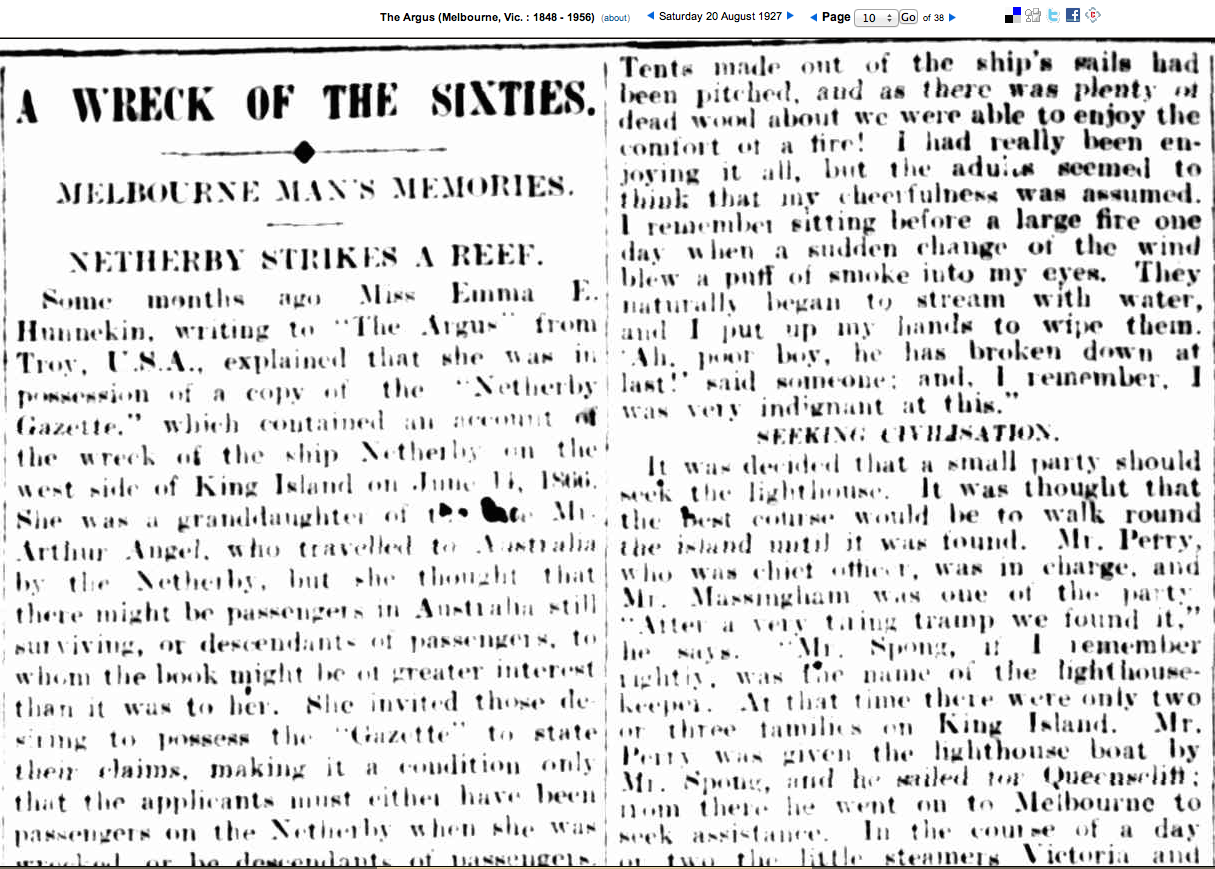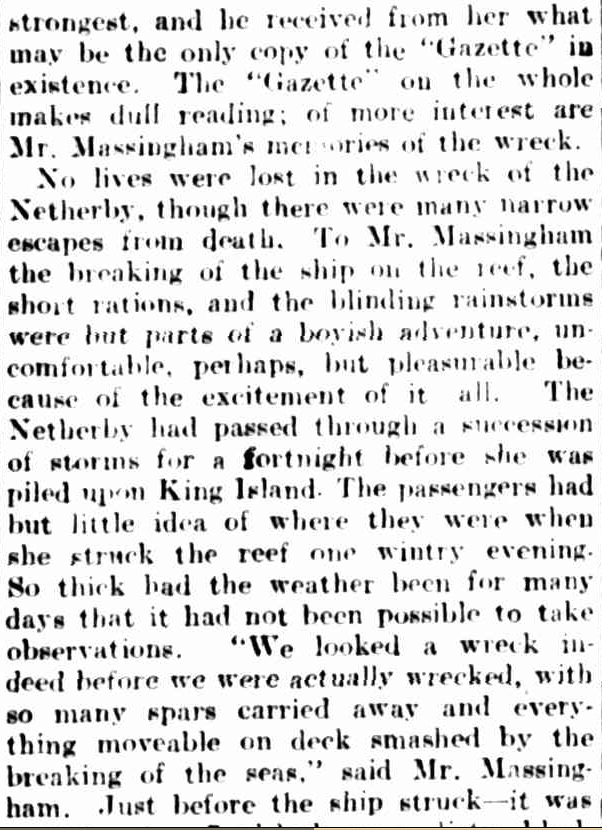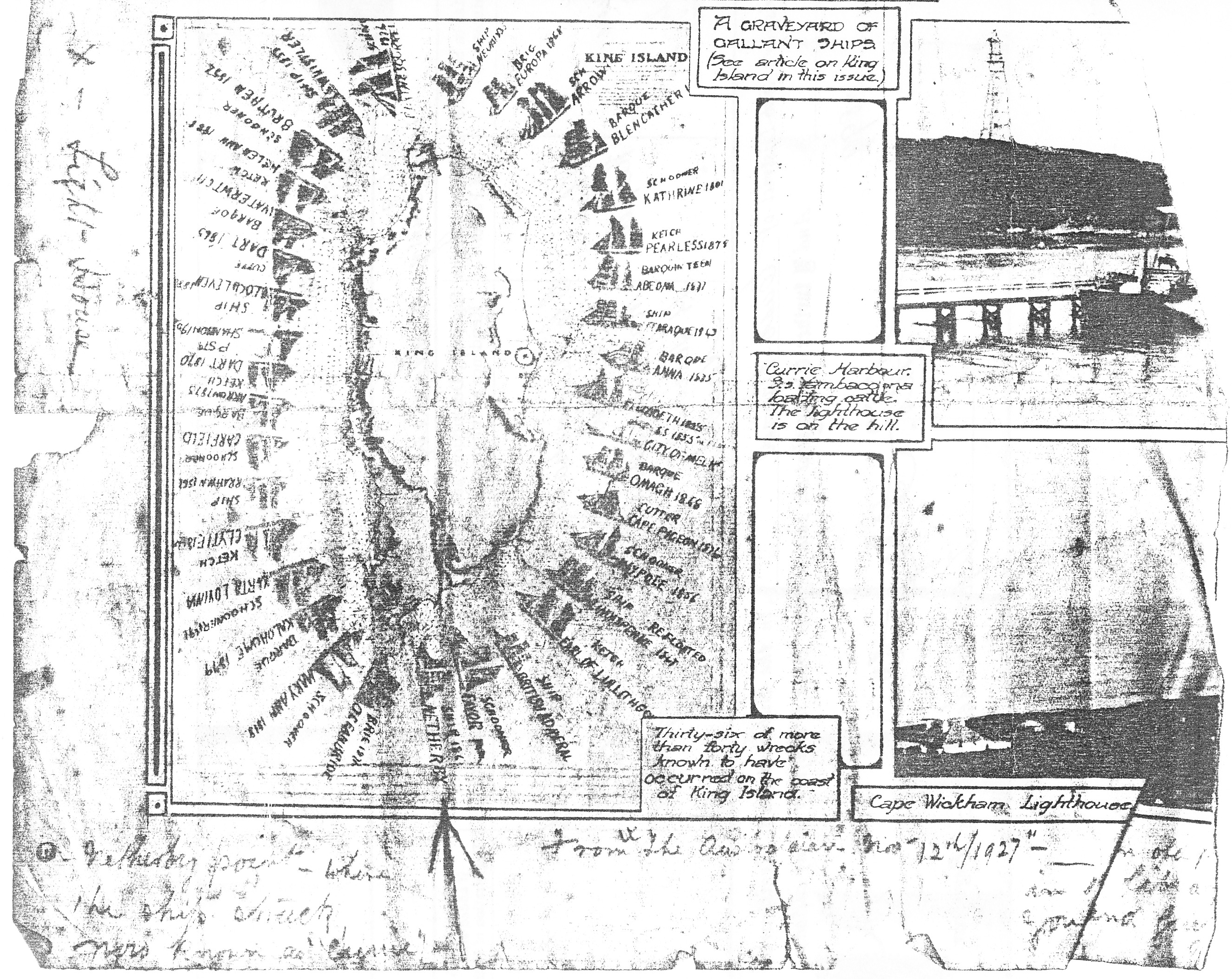My ancestor George Leake Massingham, was onboard the Netherby travelling alone, aged just 16. He wrote an extremely descriptive letter home to his mother in England right after the shipwreck and I would like to share the contents of that letter (HERE), along with the many other sources of information I have since found regarding the shipwreck.
George was my great great grand-uncle and it always fascinated me that someone so young would be so brave as to travel across the world to a new country on his own.
George went on to be a well known portrait and landscape photographer in Queensland and Victoria, with much of his work retained in the National Library of Australia (see slideshows below). George was interviewed by The Argus (Melbourne) 20 August 1927 about his memories of the shipwreck. That article is further below on this page, as is George's family tree (in progress).
TRANSCRIPT
The Argus (Melbourne) 20 August 1927
A WRECK OF THE SIXTIES.
MELBOURNE MAN'S MEMORIES, NETHERBY STRIKES A REEF.
Some months ago, Miss Emma E. Hunnekin, writing to "The Argus" from Troy, U S A, explained that she was in possesion of a copy of the Netherby Gazette, which contained an account of the wreck of the ship Netherby on the west side of King Island on June 11 1866. She was a grand-daughter of the late Mr Arthur Angel, who travelled to Australia by the Netherby but she thought that ther might be passengers in Australia still surviving, or descendants of passengers whom the book might be of greater Interest than it was to her.
She invited those desiring to possess the Gazette to state their claims making it a condition only that the applicants must either have been passangers on the Netherby when she was wrecked, or be destendants of passangers In due course Miss Huneckin received 10 letters-nine from descendants of passengers and one from Mr George Leake Massingham of Frank Street Preston who as a boy of 16 had travelled by the Netherby on her last voyage Mr Massingham s claims she judged to be the strongest and he received from her what may be the only copy of the ' Gazette ' in existence.
The 'Gazette on the whóle makes dull reading of more interest are Mr Massinghams memories of the wreck.
No lives were lost in the wreck of the Netherby, though there were many narrow escapes from death to Mr Massingham the breaking of the ship on the reef, the short rations and the blinding rainstorms were but parts of a boyish adventure un-comfortable, perhaps, but pleasurable because of the excitement of it all. The Netherby had passed through a succession of storms for a fortnight before she was piled upon King Island The passengers had but little idea of where they were when she struck the reef one wintry evening So thick had the weather been for many day s that it bad not been possible to take observations
' We looked a wreck in deed before we were actually wrecked, with so many spars carried away and everything moveable on deck smashed by the breaking of the seas " said Mr Massingham Just before the ship struck it was a little after 7 o'clock on a dirty black night. Captain Owens had been sitting in the saloon talking to some of the passengers none dreaming of the disaster which was imminent Suddenly they heard the second officer, Mr Jones, cry, Put the helm hard up' Hearing this startling order, Captain Owens rushed on deck Through the murk there could be seen land looming up close to the starboard bow, and they could hear the roar of breakers. Immediately after this the Netherby struck a reef and begnn pounding heavily. An hour Iater she was leaking like a sieve.
GETTING ASHORE
Passengers as well as the crew manned the pumps but no impression could be made against the inrush of water soon the whole lee side tween decks was awash The safety of the women and the children was the captains first consideration they were assembled in the cabin and they behaved well The pinnace was launched with the intention of taking a rope ashore but it was almost immediatley stove in Eventually the crew of another of the ships boats succeeded in secuting a rope to a projection on the reef. and this served to pull the boat backwards and forwards hand over hand between the reef and the ship. The sea had subsided somewhat and eventually all were safely landed on the reef and they got ashore
The prospect was dismal Everyone was soaked to the skin, not had anyone procured a change of clothing so quickly had the ship broken up. There was no chance of drying such clothes as they had for the rain effectually prevented that. Parties were sent to search for food among the wreckage washed ashore but all that could be discovered at first was a barrel of flour some biscuits and a little preserved meat. Among 400 this would not go far so everyone was put on very short rations the women and children receiving a little more than the rest. A large quantity of flour, meat, and other foodstuffs had come ashore but it had been overlooked.
The refugees were therefore as Mr Massingham said, starving in the midst of plenty But by great good fortune some of the passengers before leaving the wreck had taken their guns together with powder and shot. Thus we were able to shoot a few kangaroo said Mr Massingham and we helped the kangaroo meat out with limpets scraped off the reef. These we ate raw as if they had been oysters and perhaps because we were very hungery they did not taste all bad
Tents made out of the ship s sails had been pitched and as there was plenty of dead wood about we were able to enjoy the comfort of a fire! I had really been enjoying it all but the adults seemed to think, that my cheerfullness was assumed.
I remember sitting before a large fire one day when a sudden change of the wind blew a puff of smoke into my eyes. They naturally began to stream with water, and I put up my hands to wipe them all poor boy, he has broken down at last!' said someone and I remember I was very indignant at this '
SEEKING CIVILISATION
It was decided that a small party should seek the lighthouse. It was thought that the best course would be to walk round the island until it was found Mr Perry, who was chief offiecer was in charge and Mr Massingham was one of the party
After a very tiring tramp we found it" he says. Mr Spong, if I remember rightly, was the name of the lighthoues keeper At that time then were only two or three families on King Island Mr Perry was given the lighthouse boat by Mr Spong', and he sailed for Queenscliff from there he went on to Melbourne to seek assistance In the course of a day or two the little steamers Victoria and Phaios came to our rescue. And they had to make a couple of trips, before they got us all off. The Victoria took 240 aboard including all the women and children. As the weather was still stormy the embarkation was not without danger but though some were bruisedl no one was seriously hurt. An abundance of hot soup and other food had been prepared and there were spirits and wine for those that needed them.
When we got to Melbourne the Victorian Government came to our rèscue and we were most hospitibly treated. We had quarters in the old Exhibition Building and elsewhere and a reliel committee collected 700pounds to buy necessaties for those who had no money. The agents of James Baines and Co of Liverpool the owners of the Netherby provided us with passages to Queensland for it is was to that State, that we were bound "
Considering how very little was saved it is remarkable the salvage should have included the tiles (handwritten) of the Netherby Gazette but what the ship s papers were to Captain Owens so were those previous documents to the joint editors. Messrs Vincent and Townsend.
It was from these complete files that the little volume of the 'Gazette ' was printed by W. B. Stephens of 115 Collins street Melbourne a copy of which is in Mr Massinghams possession.
Back to TOP of page
Interestingly, George's birth certificate has his middle name spelled Leak - but every other reference to it I can find after that spells it Leake. The family consensus is that he chose to spell it Leake.
Many of George's photographic works are held by state and federal archives. Some examples below from State Library of Victoria.
State Library of Victoria records also show his studio address as 102 Moorabool Street, Geelong, between 1889 and 1894
Other information collected about George:
Occupation Photographer Aug 1866-Jul 1877 Queensland, Australia Travelling photographer to Brisbane, Toowoomba, Ipswich, Dalby, Gympie, Townsville, Ravenswood, Middle Camp and Charters Towers.
Occupation Travelling Photographer Dec 1868-Aug 1877 Sydney, New South Wales, Australia
Occupation Travelling Photographer Feb 1869-Sep 1877 Melbourne, Victoria, Australia
Occupation pre 1876 Sydney, New South Wales, Australia Photographer (Italian Studio) at 480 George Street
Occupation 1876/1877 Toowoomba, Queensland, Australia Photographer (Italian Studio) at Ruthven Street
Travel to visit family After Sep 1877-Feb 1880 England
Immigration 15 Feb 1880 to Melbourne, Victoria, Australia Unassisted immigrant on ship "Somersetshire" from Gravesend, London. On the passenger list George is shown as a Clerk and was continuing the voyage to Sydney.
Occupation Photographer Abt 1880 Sydney, New South Wales, Australia
Occupation Photographer at Howard Place 1881 Bendigo, Victoria, Australia
Occupation Photographer 16 May 1883 Sandhurst, Victoria, Australia
Occupation Apr - Jul 1884 Donald, Victoria, Australia, Photographer - Manager Gove & Allen
Occupation Photographer 1886 Geelong, Victoria, Australia
Occupation 1887/1889 Geelong, Victoria, Australia, Photographer at Moorabool Street
Occupation 1891/1897 Geelong, Victoria, Australia, Photographer at 169 Moorabool Street
Occupation 1899 Geelong, Victoria, Australia, Photographer at Latrobe Terrace
Occupation 1901 Newtown, Geelong, Victoria, Australia, Photographer at 28 Latrobe Terrace
Occupation 1901/1902 Newtown, Geelong, Victoria, Australia, Photographer at 26 Latrobe Terrace
George's Genealogy: You can scroll left, right, up and down within this inline frame.
George's record
Above is an old photocopy I had since the 80s of the inner page of George's bible. Not the one he carried with him on the Netherby, but one presented to each passenger after the shipwreck by the Victorian Auxiliary Bible Society.
George used his a diary and recorded all the towns he lived and worked in. Thanks to his descendant Suzanne Barton I can now share photos of the bible and its inner pages.
The Story of George Massingham





















